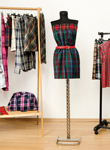
When beginning any retail business, it is important to clearly understand what type of goods you will be supplying. Never is this more important than when dealing with a fashion store. Everyone needs clothes but not everyone wears the same style. Trying to satisfy every gender, age range and type of person is impossible, even if you are a massive retailer. For smaller boutiques, it is even more imperative to use the limited space (and budget) you have wisely, and choose garments that complement each other so that if someone comes in for a top, they might just leave with the matching shoes.
1) Specialize
Obviously, if you have the space and the funds, selling men and women’s clothing is great. However, for a small fashion store you should choose one or the other. Let’s just say you decide to open a ladies fashion store. The next step is to identify your target market. What is their age range? This may seem like an obvious question, but it is surprising how many small clothing retailers struggle to define a specific age range when stocking their clothing. If you estimate that 90% of your customers will be aged 18-30, it is not necessarily a good idea to sell oversized floral blouses and Orthopaedic shoes. Sell stock that will appeal to your target age range. Once your age and gender have been defined, you need to think about what type of person you intend to stock to. Is your ideal customer the sporty girl? Great, stock up on matching track suits and neon gym gear. Or maybe she is the grungy girl? Get crop tops and vintage inspired pieces. You cannot cater to everyone with a small store, so do not try. Define your audience and appeal to them.
2) On Trend-With a Twist
This is where you need to do your homework, or work with a wholesale company who will do it for you. On-trend items are a great way to attract new customers, but they have a limited shelf life. Last season’s clothing fad is this season’s charity shop stock, so buy a smaller amount of this type of stock. As well as this, you are going to have competition from lots of other clothing stores when selling the season’s latest trends. To avoid this, source your clothes from a little known supplier, or try to find a wholesaler that stock a different print or slightly altered cut.
3) Classic Styles
Stocking the latest trends is great. But ensuring that a few essential clothing items are always in stock is a great way to earn steady revenue. Girls will always need casual clothing, so stock some basic camisoles and t-shirts which can be worn all year round. Jeans are also great essential items, which go through trend fluctuations too. They are an easy way to remain ‘on-trend’ while also providing a garment that never goes out of style. Ripped jeans are having their moment right now, along with super skinny high-waisted jeans. Next season, a slightly different take on the jeans is bound to be in vogue. Keep your eye on the celebrities for a tip off as to what is going to become the next trendy-jeans style.
4) Seasonal Stock
We are not talking about the fashions seasons here, but the annual, weather-led seasons. Yes, strappy dresses are worn around the festive party season, but there is no point in stocking up on only dresses in the winter months. It is important to have a selection, but when starting out, remember to stick to the items of clothing that are weather appropriate for the season in which you launch or risk wasting an entire season’s worth of stock, which may be out of style when next year comes around.
5) Accessories
A great way to keep a steady stream of money coming into your business, accessories knows no seasons. Small and easy to display, offering a selection of jewelry, bags and even shoes is the perfect way to make sure your customers keep coming back. They are generally a cheaper option than the other products in the store and therefore, in general, more units are sold. Make sure you stock items that complement other clothing that you have in the store perfectly. Your customers will not be able to resist picking up the clutch bag that perfectly matches their new dress.
In general, sticking to these brief guidelines should give you a somewhat concise indication of what products to stock when setting up a small fashion store. We know that you will want to supply every garment that catches your eye, but resist the urge; space and budget should always be at the back of your mind when selecting goods.

